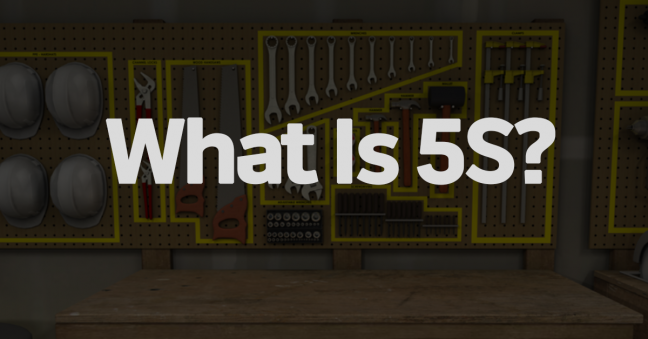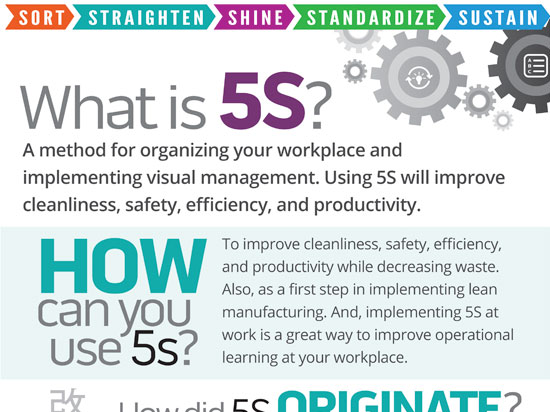
5S is central to lean manufacturing, and it’s frequently one of the first parts of a lean manufacturing implementation at the workplace.
In this article, a continuation of a series of articles introducing key lean manufacturing tools and concepts, we’re going to briefly introduce you to 5S.
Before you begin reading about 5S, know that we’ve included a free What Is 5S? infographic at the bottom of this article.
- Learning Management Systems
- Online 5S, Lean Manufacturing, and Continuous Improvement Training Courses
- Online Manufacturing & Maintenance Training Courses
- Incident Management Software
- Mobile Training Apps
Defining 5S
5S is a formulaic method you can use to straighten and organize a work area. Using 5S reduces waste (a fundamental goal in lean manufacturing), improves safety (see our article on Lean 6S Safety), and otherwise improves your production process and work environment.
5S is called 5S because their are 5 steps and each step begins with the letter “S” (and/or the sound “s”). This is true in the original Japanese and it’s true in the English translation as well. The five steps of 5S are:
- Seiri, or Sort
- Seiton, or Straighten
- Seiso, or Sweep/Sanitize
- Seiketsu, or Standardize
- Shitsuke, or Sustain
A Closer Look at the Five Steps in 5S
Let’s take a closer look at each of the five steps in 5S.
5S Step 1, Sort (Seiri)
The first step in the 5S process is to sort.
This means sorting the materials at your work place. In particular, identify all the things in the workplace (tools, equipment, etc.) that are laying around but that you never use and/or don’t use regularly. Put these in a pile or area and prepare to give them away, sell them, dispose of them, or put them into long-term storage so they don’t clutter up your work area. Lean professionals often put a red tag on these items, identifying them for removal.
5S Step 2, Straighten (Seiton)–Also Known as Set in Order
After you’ve removed the stuff that you don’t need in the work area, you can begin thinking about the stuff that’s left and consider the best places to put them all. Remember, you’re looking for ways to maximize efficiency, decrease waste, reduce ergonomic strain, and similarly improve your work processes.
You’ll want to put things that are used often in a nearby place where they’re easy to grab. You might also want to use tape or paint to mark areas for each tool/equipment/machine (this is borrowing from lean’s emphasis on visual workplace management).
Quick tip: reading up on lean value stream mapping may be an aid at this point.
The short sample video from a 5S elearning course by Convergence Training explains straightening, including the ideas of reducing waste, improving efficiency, and using visual workplace management techniques.
Check out our other training courses on the lean 5S method as well.
5S Step 3, Shine (Seiso)–Also Known as Sweep or Sanitize
Once you’ve got everything in its right place, it’s time to clean the work area.
And this doesn’t mean just clean it once. It means to set up a schedule to clean it on a regular schedule and make sure that schedule gets carried out.
You’ll learn that daily/regular cleanings are a great opportunity to inspect the work area and machines for damage or anything else that’s gone wrong. This is just one of the many ways that lean techniques such as 5S are useful to maintenance professionals, safety professionals, and continuous improvement professionals.
One benefit of daily cleaning is you can use it as an opportunity to inspect the work area and machines for wear and damage.
5S Step 4, Standardize (Seiketsu)
The next step in the 5S process is to standardize.
Standardizing means to develop best practices/SOPs so your company has a better chance of keeping things organized, clean, safe, and efficient.
Be sure to include responsibilities for sorting, straightening, and shining into people’s work responsibilities so it’s always done.
As you continue your studies of lean manufacturing, you’ll discover that standardization is central to lean. Along those lines, you may want to read our What Is Standardized Work? article.
5S Step 5, Sustain (Shitsuke)
In the last (and continuing) phase of 5S, sustain, you’ve got to take those schedules and keep ’em going.
This can be a tough part of 5S. It’s not unusual for a company to implement 5S, get off to a good start, see positive results, and then just revert to the previous state. That’s just how people are sometimes.
So you’ll want to do things to (1) ensure that your new 5S practices are being carried out but also (2) encourage, inspire, and motivate people to keep practicing 5S at work. To do that, keep the importance, value, and rewards of 5S top of mind–talk about it, present data showing its positive influence at your workplace, put up some signs and posters, and have some meetings discussing it.
Final Thoughts on 5S
We wish you good luck with your 5S implementation and welcome any questions you may have about 5S and lean (just use the comments below).
Here are a few additional thoughts about 5S for you:
- 5S is often used as the first step of a lean manufacturing implementation
- 5S improves not only efficiency, but also safety and operational learning
- 5S was created in Japan as part of the Toyota Production System (TPS) that is associated with the origins of lean
Before you leave, be sure to download our free What Is 5S? Infographic!

Free “What Is 5S?” Infographic Download
Download this free infographic explaining 5S, one of the foundations of lean manufacturing.
This is excellent. Clearly explained. We’ve implemented 5S in our office and it made a huge difference in the work environment. Less clutter, more efficient work place.
Bilal, it’s great to hear folks discuss their real experiences with 5S, etc. Thanks for sharing that!